COVID-19 among rural peoples in the Peruvian Amazon
Project
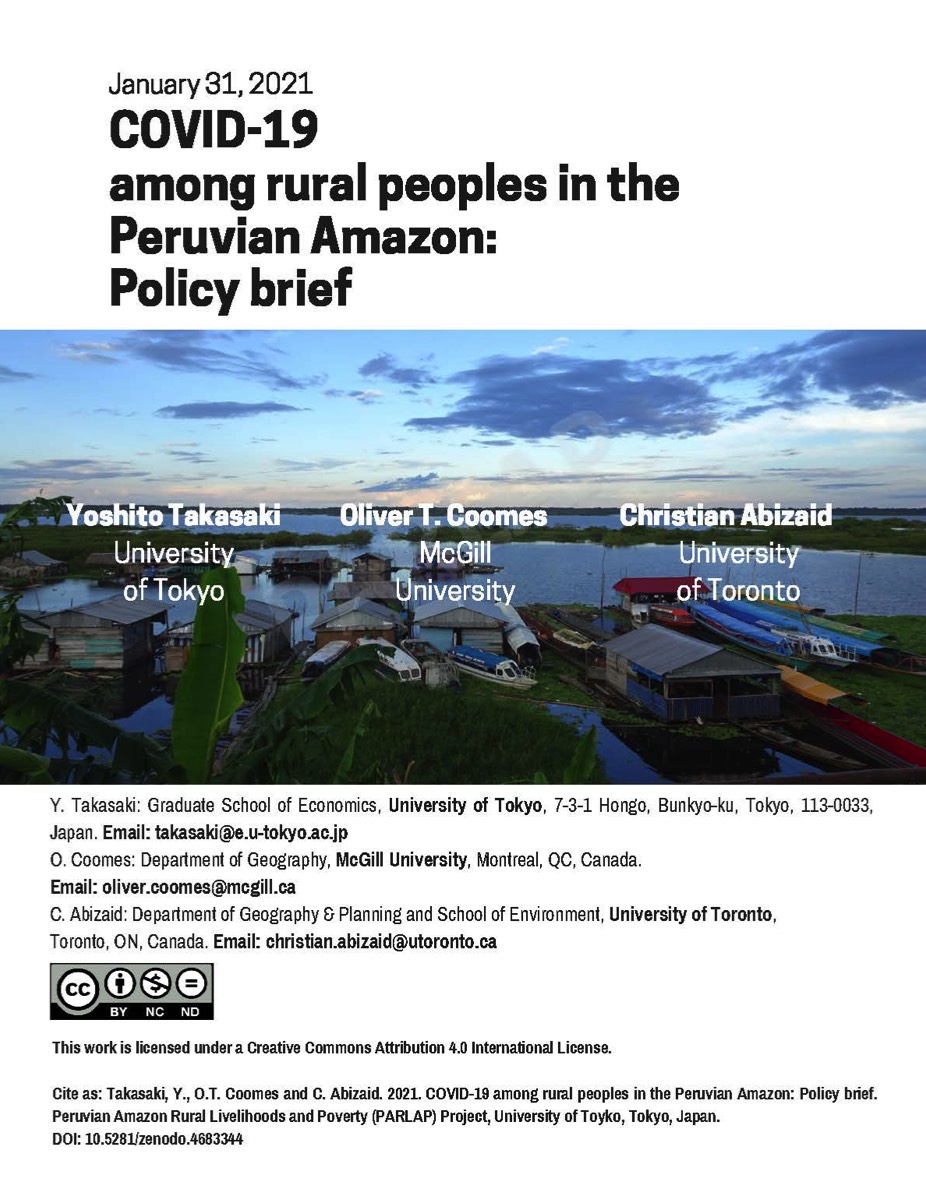
< NEW > : See our COVID-19 Policy Brief
Peru ranks among the countries most severely affected by COVID-19 in the world, despite instating one of the earliest and longest quarantines in Latin America and an ambitious social program aimed to assist families with the economic consequences of the pandemic. Peru has struggled to flatten the curve while at the same time taken steps to reopen economic activity amidst an acute recession.
The COVID-19 pandemic hit the Peruvian Amazon in mid-March and sparked international concern about the well-being of the indigenous and non-indigenous peoples of the region. Although the two major urban centers – Iquitos and Pucallpa – received media attention, information about conditions in the many smaller rural communities along the rivers of Loreto and Ucayali regions is scarce. The case and mortality data provided by the Peruvian Government for the two regions is invaluable but reflects conditions in more urbanized communities – those with some health facilities – but most rural communities have none, lack reliable means of communication, and many are just too remote, making it difficult to discern the impacts of COVID-19 in much of the Peruvian Amazon. To remedy this lacuna, and with a concern about the people that we work with, we undertook a large-scale survey by phone among communities in the PARLAP study area that captures the rural prevalence of COVID-19 and its consequences.
Our baseline phone survey conducted in July 2020 covered 470 communities (370 in Loreto, 100 in Ucayali; 56% indigenous, 44% campesino) with phone access, which account for over 50% of 919 communities covered in our original community survey. Many communities still cannot be reached by phone. We subsequently conducted a follow-up phone (midline) survey in August and early September which reached 436 of the 470 communities (93%), and a series of more in-depth qualitative phone interviews with a small number of communities. Together, these instruments provide us with unique information about the prevalence of COVID-19, potential cause of spread, protection measures employed, assistance received, people’s responses and concerns over time.
By combining COVID data with our original PARLAP community survey, remote sensing and GIS data, we plan to examine how COVID-related measures are related to various community, geographical, and environmental factors. Findings from this research promise to provide policy-relevant insights for health care, poverty alleviation, and conservation during and after the pandemic.
Peru ranks among the countries most severely affected by COVID-19 in the world, despite instating one of the earliest and longest quarantines in Latin America and an ambitious social program aimed to assist families with the economic consequences of the pandemic. Peru has struggled to flatten the curve while at the same time taken steps to reopen economic activity amidst an acute recession.
The COVID-19 pandemic hit the Peruvian Amazon in mid-March and sparked international concern about the well-being of the indigenous and non-indigenous peoples of the region. Although the two major urban centers – Iquitos and Pucallpa – received media attention, information about conditions in the many smaller rural communities along the rivers of Loreto and Ucayali regions is scarce. The case and mortality data provided by the Peruvian Government for the two regions is invaluable but reflects conditions in more urbanized communities – those with some health facilities – but most rural communities have none, lack reliable means of communication, and many are just too remote, making it difficult to discern the impacts of COVID-19 in much of the Peruvian Amazon. To remedy this lacuna, and with a concern about the people that we work with, we undertook a large-scale survey by phone among communities in the PARLAP study area that captures the rural prevalence of COVID-19 and its consequences.
Our baseline phone survey conducted in July 2020 covered 470 communities (370 in Loreto, 100 in Ucayali; 56% indigenous, 44% campesino) with phone access, which account for over 50% of 919 communities covered in our original community survey. Many communities still cannot be reached by phone. We subsequently conducted a follow-up phone (midline) survey in August and early September which reached 436 of the 470 communities (93%), and a series of more in-depth qualitative phone interviews with a small number of communities. Together, these instruments provide us with unique information about the prevalence of COVID-19, potential cause of spread, protection measures employed, assistance received, people’s responses and concerns over time.
By combining COVID data with our original PARLAP community survey, remote sensing and GIS data, we plan to examine how COVID-related measures are related to various community, geographical, and environmental factors. Findings from this research promise to provide policy-relevant insights for health care, poverty alleviation, and conservation during and after the pandemic.
Communities contacted in COVID-19 survey, July 2020
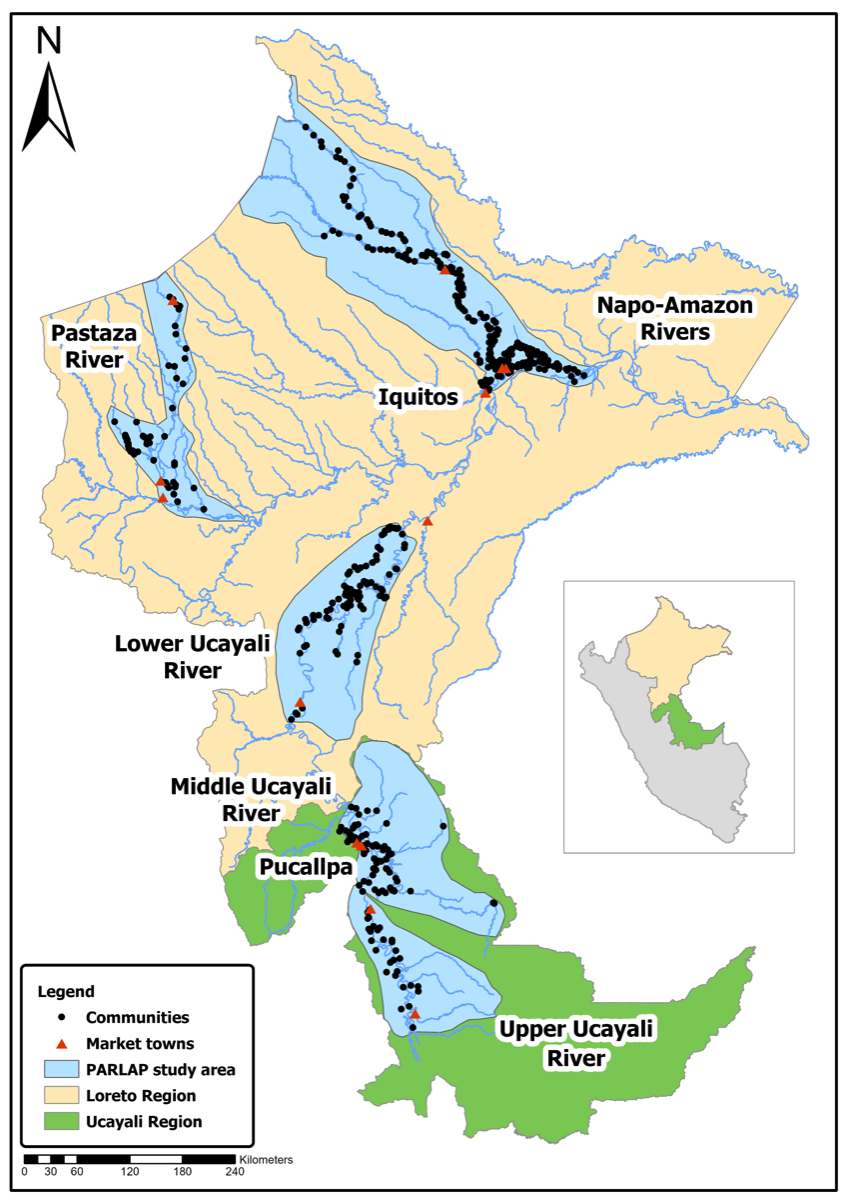
Indigenous communities contacted in COVID-19 survey, July 2020
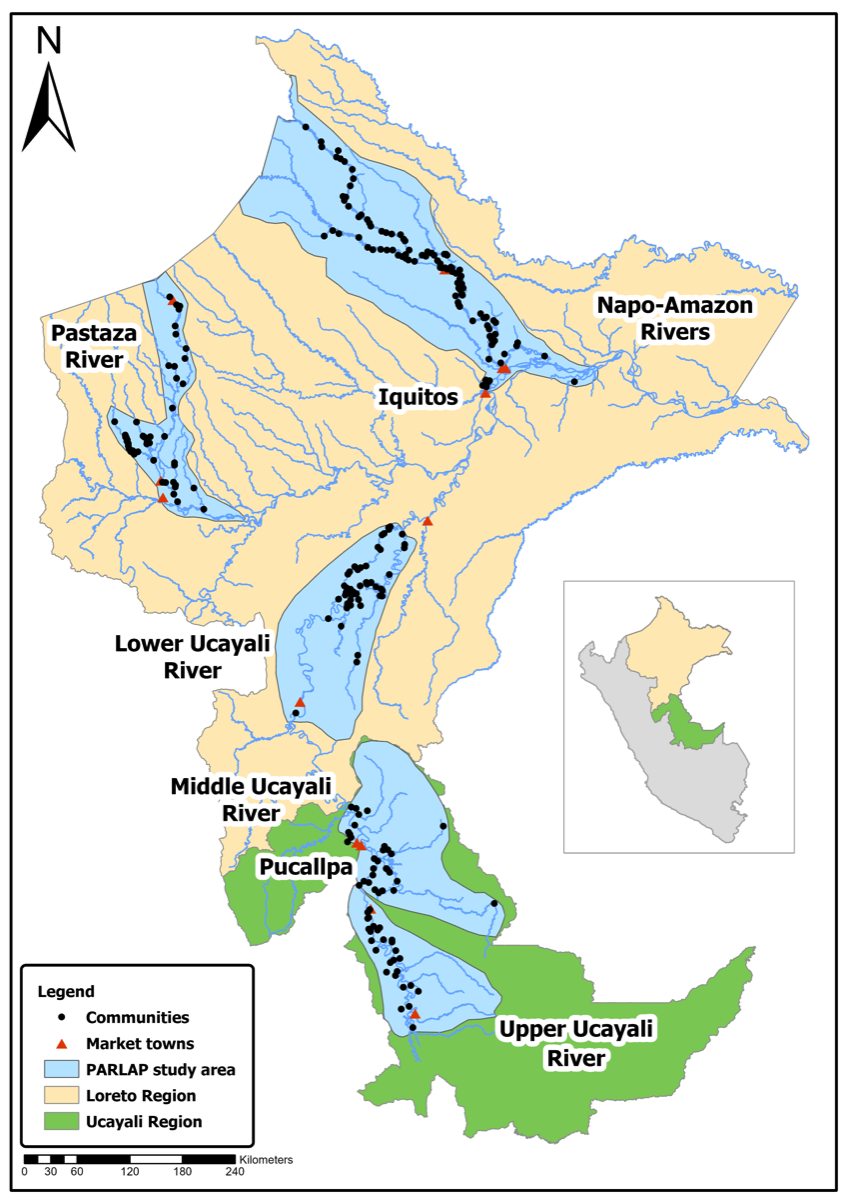
Campesino communities contacted in COVID-19 survey, July 2020
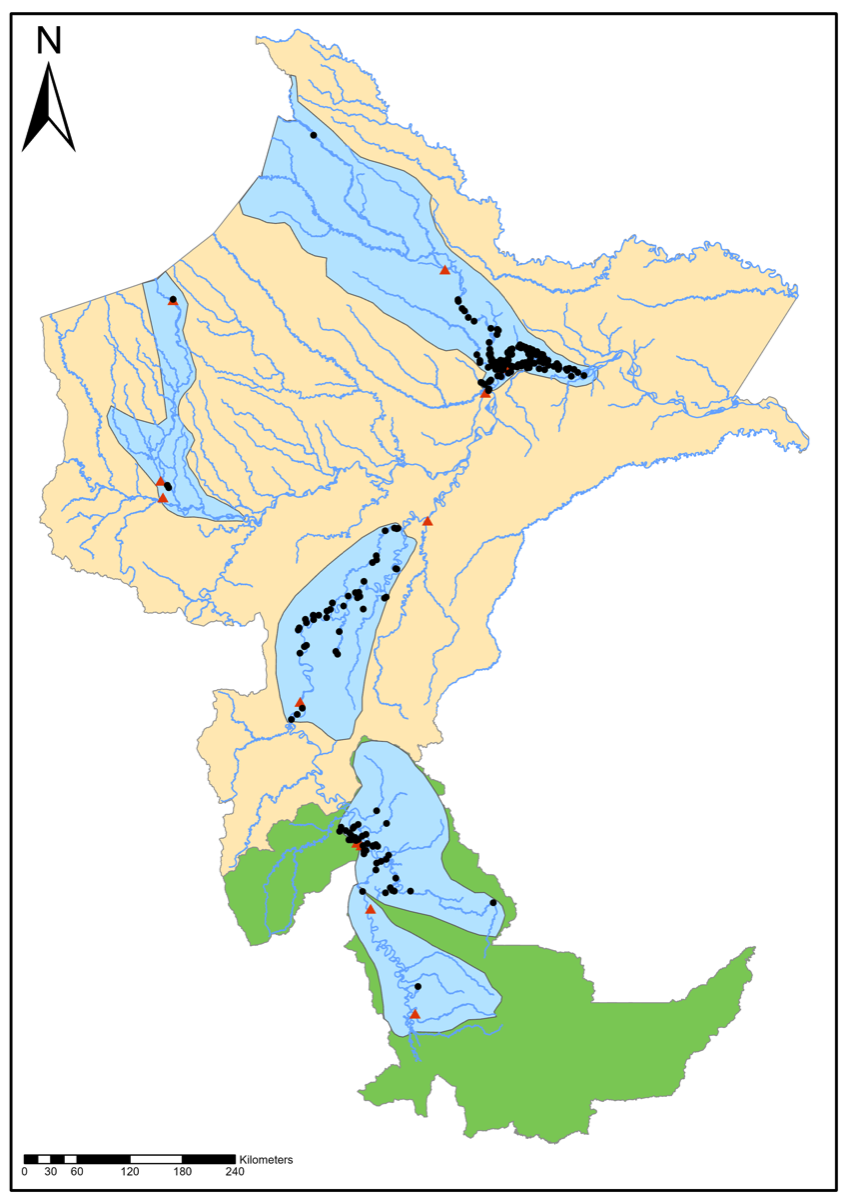
Highlights
Daily COVID-19 cases in the Peruvian Amazon (March, 2020 until June, 2021).
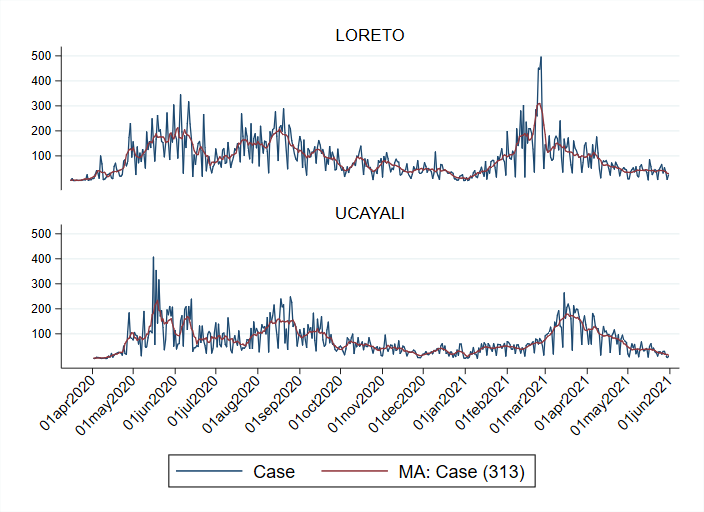
Source: Revised estimates from Ministerio de Salud, Peru (June 2021).
Daily mortality due to COVID-19 in the Peruvian Amazon (March, 2020 until June, 2021)
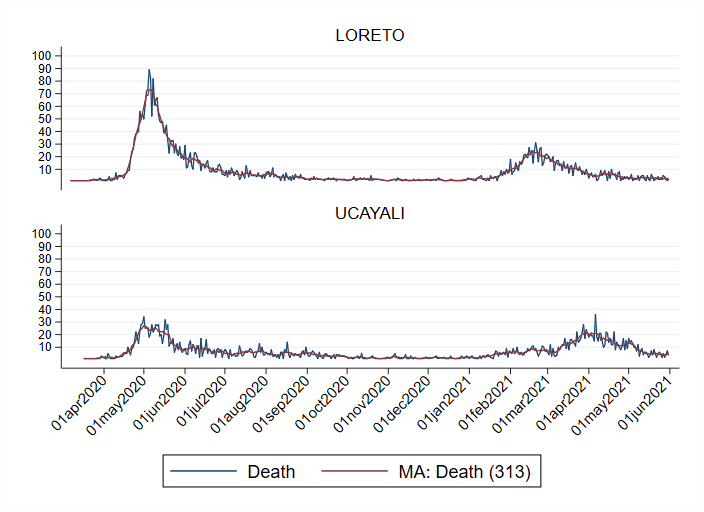
Source: Revised estimates from Ministerio de Salud, Peru (June 2021)
Finding:
COVID-19 has spread widely in the Peruvian Amazon in three waves (April-June; August; March). Mortality was highest early in the first wave and in the Department of Loreto (primarily in the city of Iquitos)
COVID-19 has spread widely in the Peruvian Amazon in three waves (April-June; August; March). Mortality was highest early in the first wave and in the Department of Loreto (primarily in the city of Iquitos)
Prevalence of COVID-19 in PARLAP study communities of Loreto and Ucayali in July, 2020
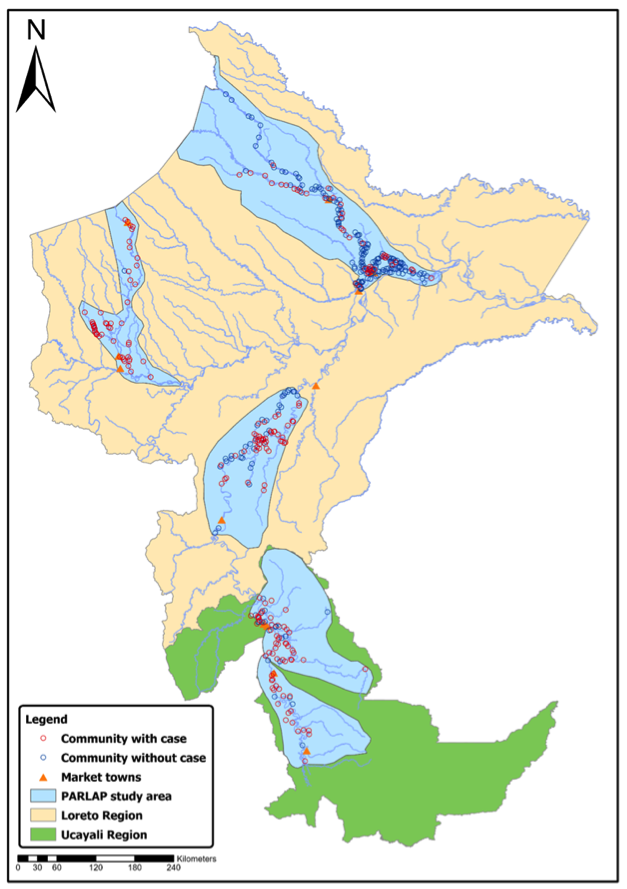
Note: 47% of communities reported at least one case of COVID-19 including suspected cases. 34% of communities indicated at least one confirmed case.
Prevalence of COVID-19 in PARLAP study communities of Loreto and Ucayali in August, 2020
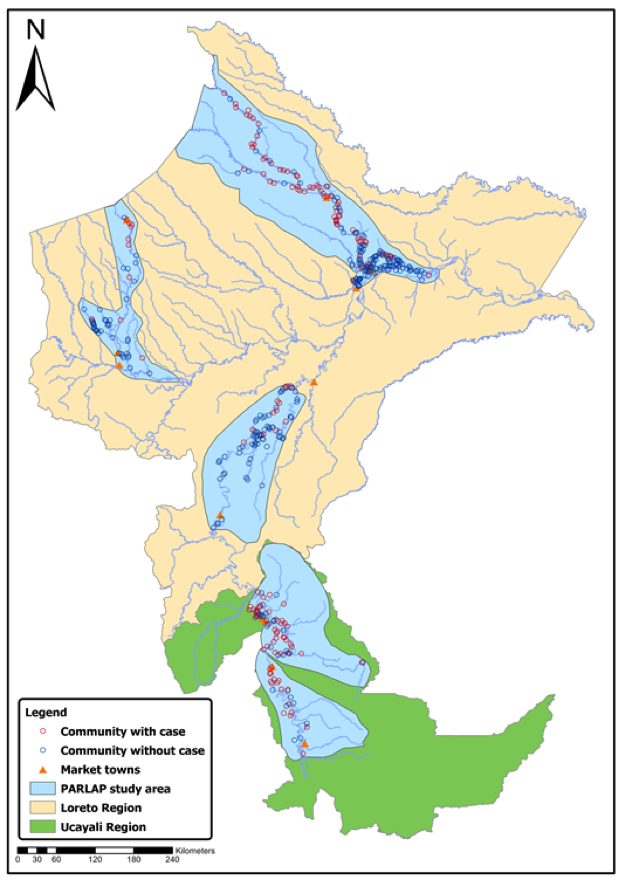
Evolution of prevalence of COVID-19 in study communities from July to August, 2020
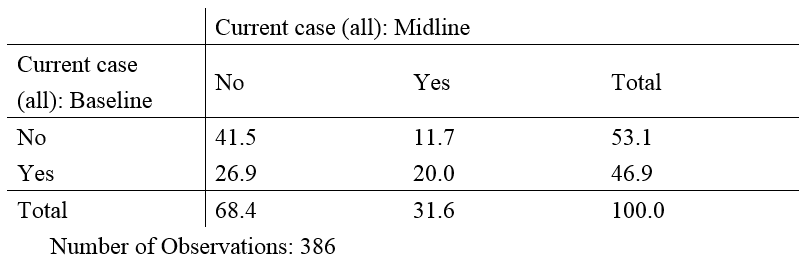
Note: Rows indicate the percentage of communities reporting COVID-19 cases in the baseline survey (July). Columns show
the percentage of communities with COVID-19 cases in the followup (midline) survey (August).
the percentage of communities with COVID-19 cases in the followup (midline) survey (August).
Mortality rate since mid-March among PARLAP communities (with any mortality)
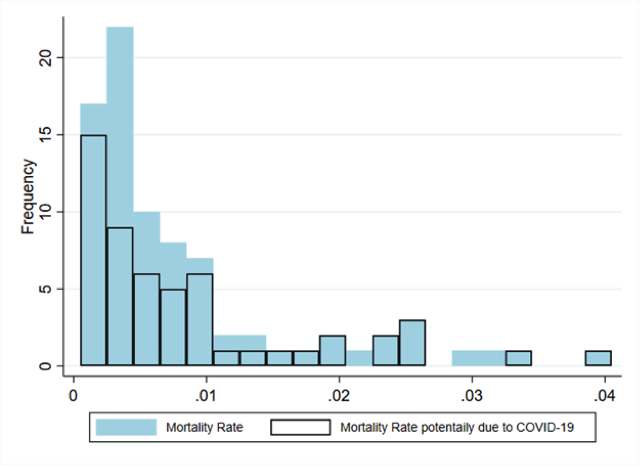
Finding:
COVID-19 has been reported in many PARLAP study communities but mortality has been relatively low. Testing in communities has been limited so the actual number of cases is uncertain. COVID-19 cases decreased in August, especially in Loreto, though new cases occurred in about a quarter of communities, especially along the Upper Napo river.
COVID-19 has been reported in many PARLAP study communities but mortality has been relatively low. Testing in communities has been limited so the actual number of cases is uncertain. COVID-19 cases decreased in August, especially in Loreto, though new cases occurred in about a quarter of communities, especially along the Upper Napo river.
Prevalence of COVID-19 in indigenous and folk communities between mid-March and July, 2020
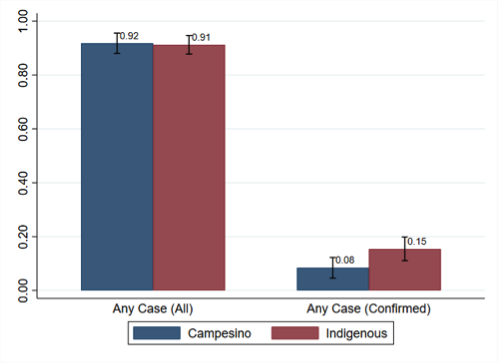
Note: The difference in Any Case (Confirmed) is statistically significant (p=0.018).
Prevalence of COVID-19 in indigenous and folk communities in August, 2020
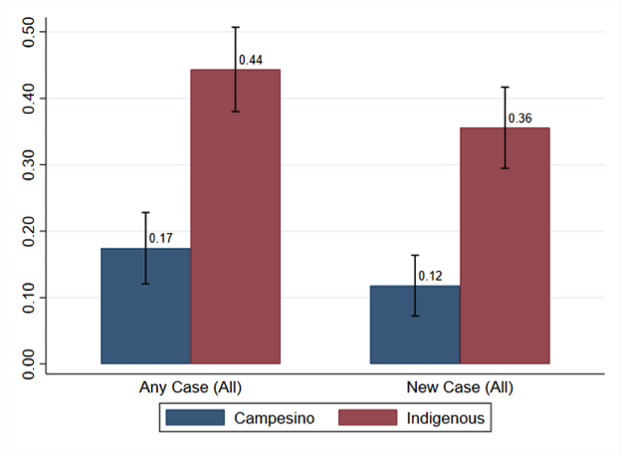
Mortality rate in indigenous and folk communities from mid-March to July, 2020
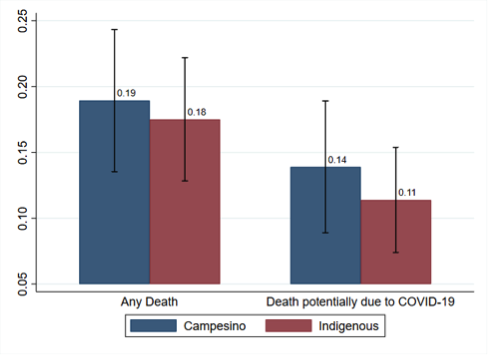
Finding:
Both indigenous and folk communities experienced similar prevalence of, and mortality due to COVID-19 between mid-March and July 2020 but confirmed cases were higher in indigenous communities. In August, COVID-19 cases were much more prevalent in indigenous communiites.
Both indigenous and folk communities experienced similar prevalence of, and mortality due to COVID-19 between mid-March and July 2020 but confirmed cases were higher in indigenous communities. In August, COVID-19 cases were much more prevalent in indigenous communiites.
Access to medical services and traditional medicine by ethnicity in July, 2020 (among communities with reported COVID-19 cases)
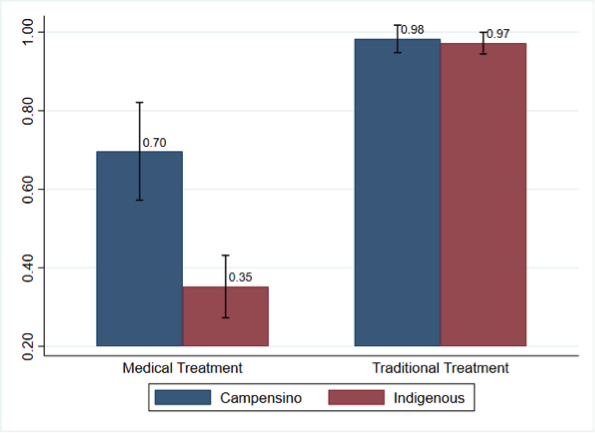
Access to medical services and traditional medicine by ethnicity in August, 2020 (among communities with reported COVID-19 cases)
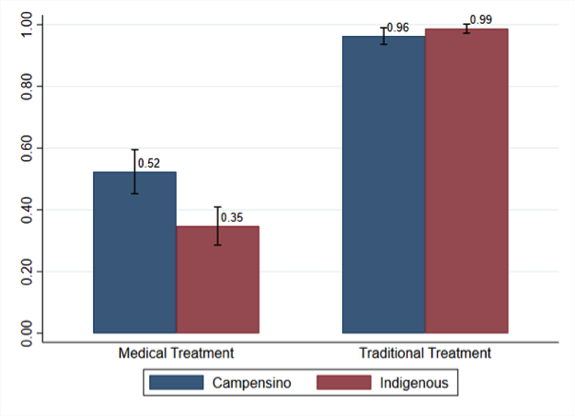
Finding:
During the pandemic access to health care has been limited (especially among indigenous communities) and rural people relied heavily on traditional remedies.
During the pandemic access to health care has been limited (especially among indigenous communities) and rural people relied heavily on traditional remedies.
Type of community gatherings by prevalence of COVID-19 in July, 2020
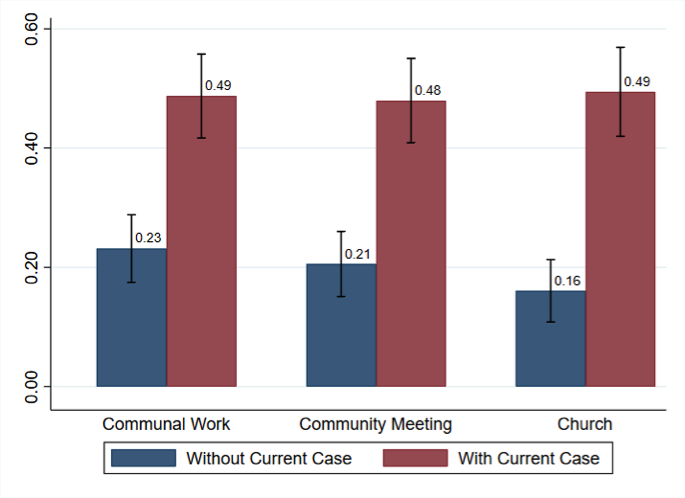
Type of community gatherings by the incidence of new cases of COVID-19 in August, 2020
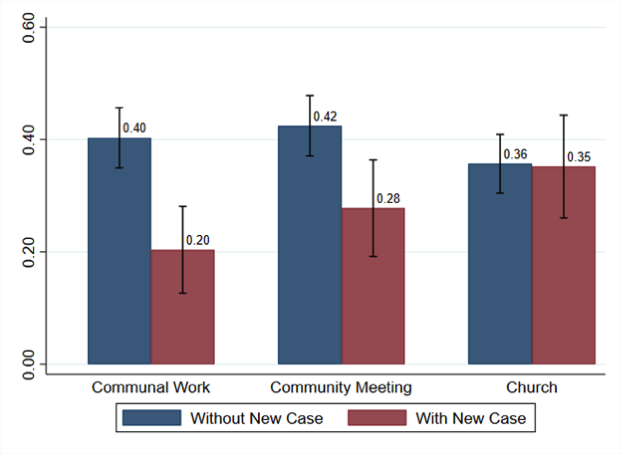
Type of community gatherings by prevalence of mortality due potentially to COVID-19 since mid-March, 2020
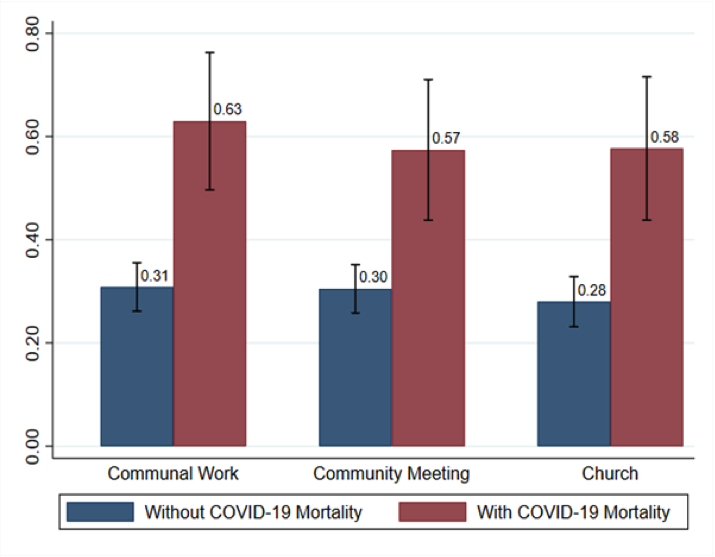
Finding:
Community transmission was an important potential cause of spread during the first wave. People reduced community gatherings in August to reduce the spread of the virus as new cases emerged.
Community transmission was an important potential cause of spread during the first wave. People reduced community gatherings in August to reduce the spread of the virus as new cases emerged.
Wild resource us for coping during COVID-19
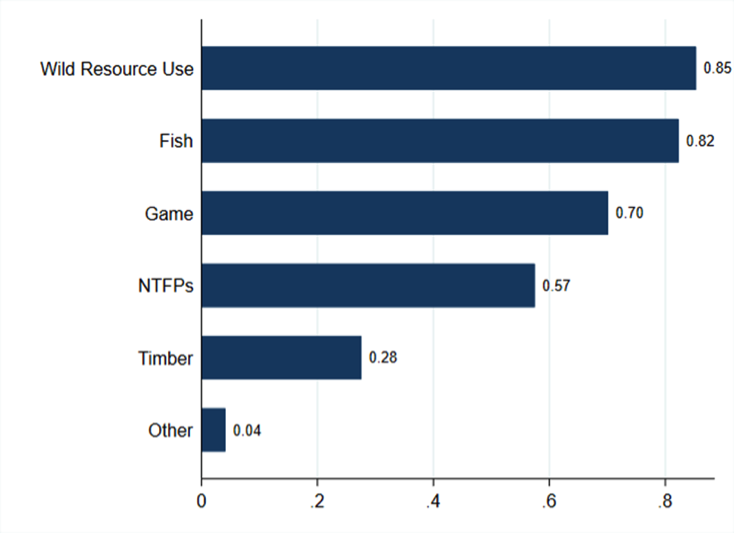
Wild resource use for coping by ethnicity during COVID-19
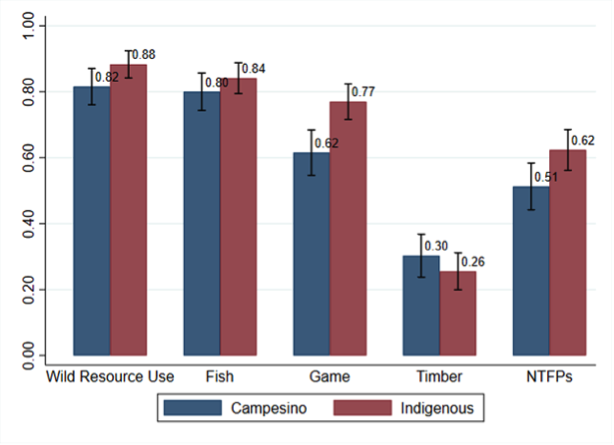
Note: The differences for "Wild Resource Use" and "NTFPS" are statistically significant (p=0.053 and p=0.021, respectively).
Motives for returning to home communities from towns and cities.
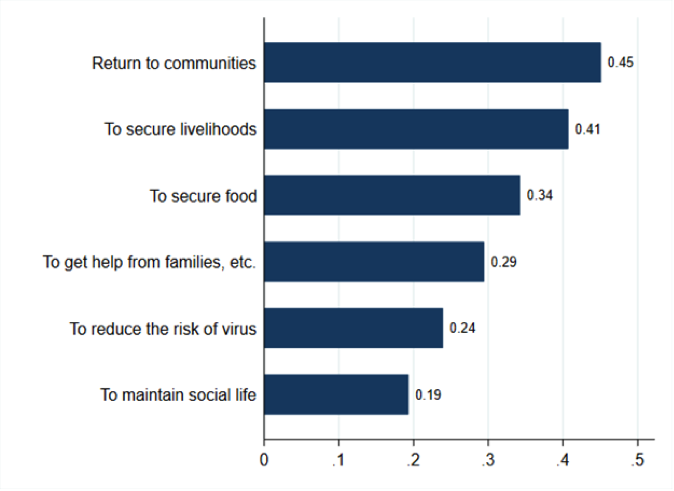
Note: The original sentence in the questionnaire is as follows: (1) "To reduce the risk of getting the virus", and (2) "To get help from families/relatives/friends for "To get help from families, etc."
Motives for returning to home communities from towns and cities by ethnicity
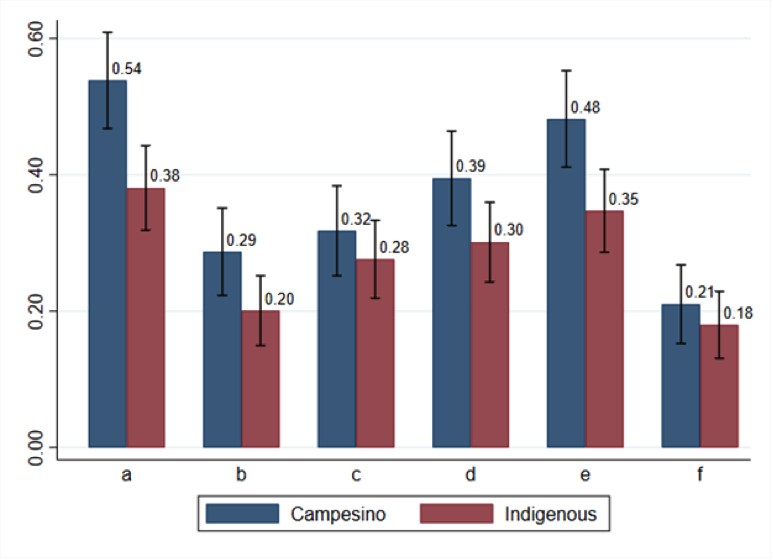
Notes: a: "Return to communities"; b: "To reduce the risk of getting the virus"; c: "To get help from families/relatives/ friends; d: "To secure food"; e: "To secure livelihoods"; f: "To maintain social life". The difference for "b" and for "d" are statistically significant (p=0.039 and p=0.043, respectively).
Finding:
Rural communities strongly relied on wild resources for coping, especially fishing, hunting, and non-timber forest product (NTFP) extraction. People living in cities and towns returned to their communities (more so among folk communities), especially for livelihoods and food.
Rural communities strongly relied on wild resources for coping, especially fishing, hunting, and non-timber forest product (NTFP) extraction. People living in cities and towns returned to their communities (more so among folk communities), especially for livelihoods and food.
Measures taken in study communities to protect against transmission of COVID-19 in July, 2020
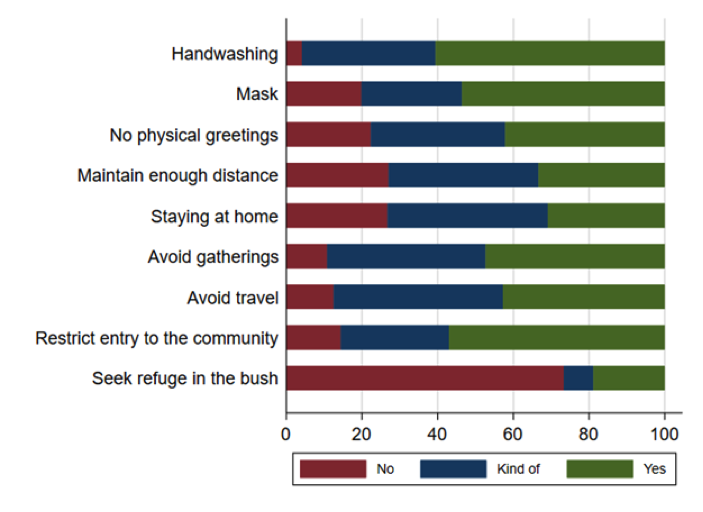
Note: The original sentence in the questionnaire is as follows: (1) “Maintain distance of at least 1 meter” for “Maintain enough distance”, (2) “Staying at home and avoid going out unless necessary” for "Staying at home", (3) “Avoid gatherings with many people” for "Avoid gatherings", and (4) "Avoid travel to other villages/towns/cities” for "Avoid travel".
Measures taken in study communities to protect against transmission of COVID-19 in August, 2020

Note: The original sentence in the questionnaire is as follows: (1) “Maintain distance of at least 1 meter” for “Maintain enough distance”, (2) “Staying at home and avoid going out unless necessary” for "Staying at home", (3) “Avoid gatherings with many people” for "Avoid gatherings", and (4) "Avoid travel to other villages/towns/cities” for "Avoid travel".
Protective measures taken by the prevalence of COVID-19 in July, 2020
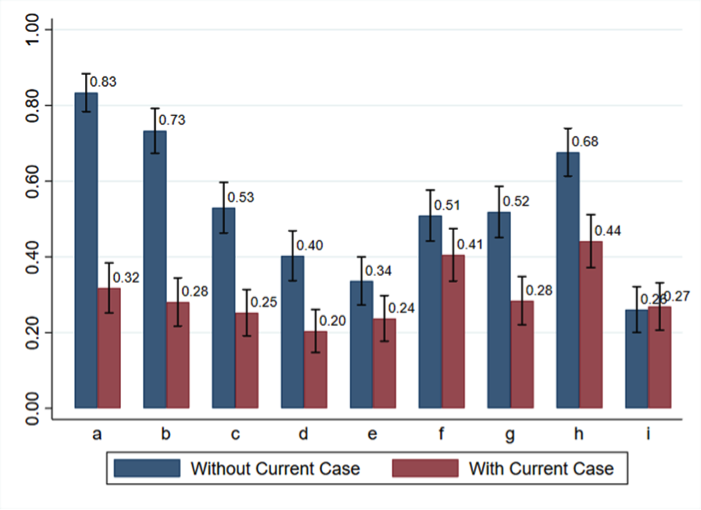
Notes: a: "Handwashing", b: "Mask", c: "No physical greetings, d: "Maintain distance of at least 1 meter", e: "Staying at home and avoid going out unless necessary", f: "Avoid gatherings with many people", g: "Avoid travel to other villages/towns/cities", h: "Restrict entry to the community", and i: "See refuge in the bush". The differences for e and for f are statistically significant (p=0.026 and p=0.034, respectively).
Protective measures taken by the prevalence of mortality due potentially to COVID-19 between mid-March and July, 2020
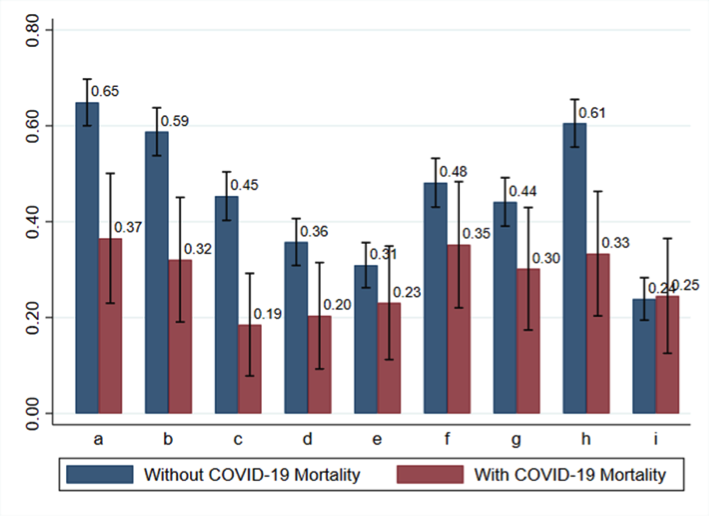
Notes: a: "Handwashing", b: "Mask", c: "No physical greetings", d: "Maintain distance of at least 1 meter", e: "Staying at home and avoid going out unless necessary", f: "Avoid gatherings with many people", g: "Avoid travel to other villages/towns/cities", h: "Restrict entry to the community", and i: "Seek refuge in the bush". The differences in d, f, and g are statistically significant (p=0.013, 0.071, and 0.046, respectively).
Protective measures taken by incidence of new cases of COVID-19 in August, 2020
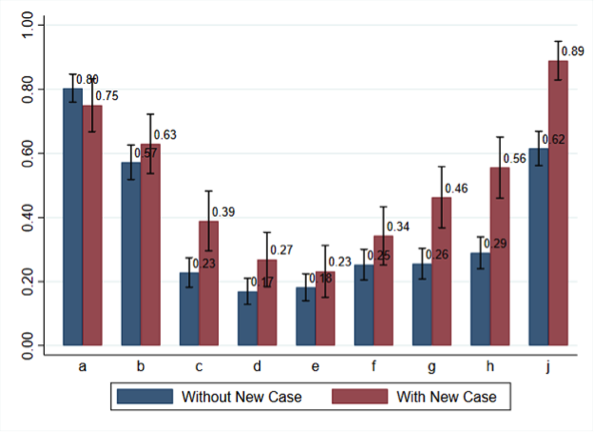
Notes: a: "Handwashing", b: "Mask", c: "No physical greetings", d: "Maintain distance of at least 1 meter", e: "Staying at home and avoid going out unless necessary", f: "Avoid gatherings with many people", g: "Avoid travel to other villages/towns/cities", h: "Restrict entry to the community", and i: "Seek refuge in the bush". The differences for e and for f are statistically significant (p=0.039 and 0.083, respectively).
Finding:
Protective measures taken in communities varied - difficulties in maintaining social distance. Protective measures potentially reduced mortality due to COVID-19. Although in August people employed more often some measures such as hand washing and mask, they became more socially active and mobile. Communities employed protective measures in response to new cases of COVID-19
Protective measures taken in communities varied - difficulties in maintaining social distance. Protective measures potentially reduced mortality due to COVID-19. Although in August people employed more often some measures such as hand washing and mask, they became more socially active and mobile. Communities employed protective measures in response to new cases of COVID-19
Types of assistance received by study communities between mid-March and July, 2020
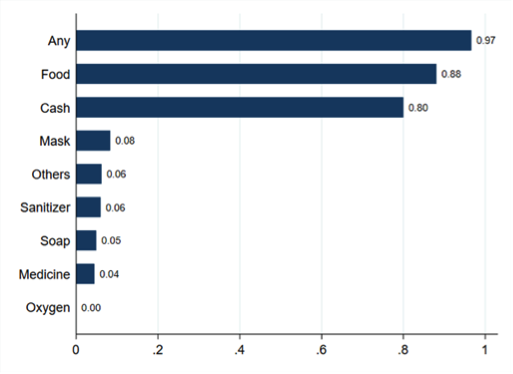
Types of assistance received by study communities during the previous 7 days in August, 2020
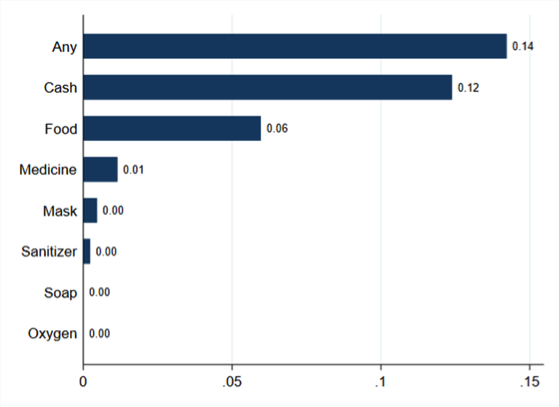
Sources of assistance received between mid-March and July, 2020
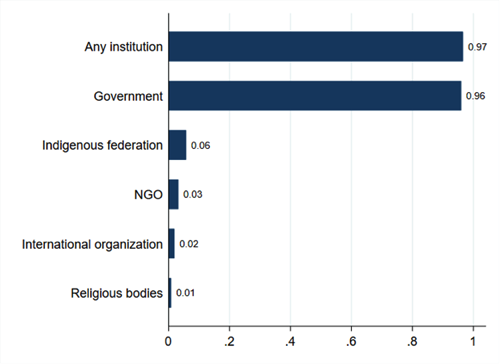
Sources of assistance received during the previous 7 days in August, 2020
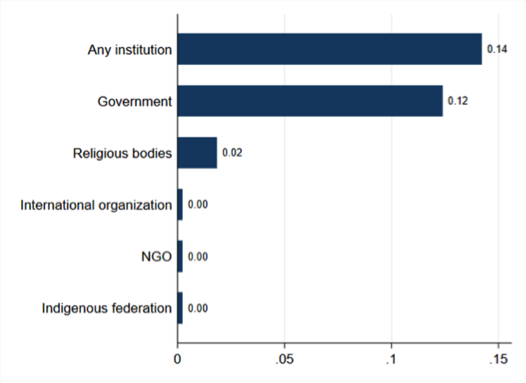
Assistance received by the prevalence of COVID-19 between mid-March and July 2020
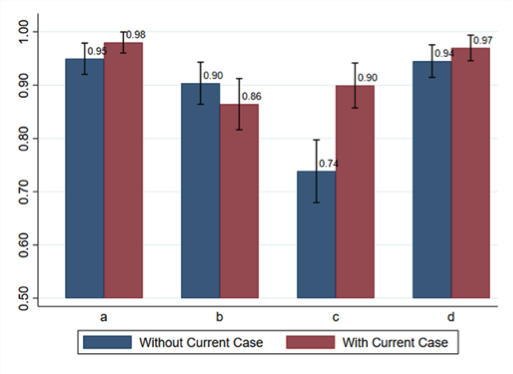
Notes: a: Any assistance from any institution, b: Food from any institution, c: Cash from any institution, d: Any assistance from government.
Assistance received by the prevalence of mortality potentially due to COVID-19 between mid-March and July 2020
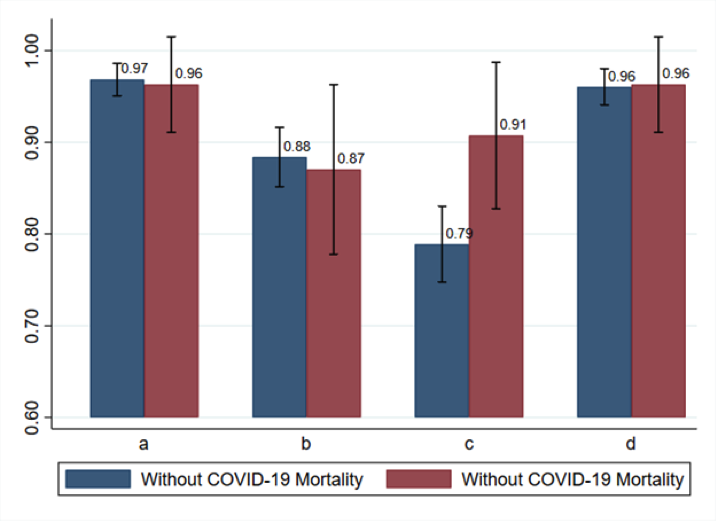
Notes: a: Any assistance from any institution, b: Food from any institution, c: Cash from any institution, d: Any assistance from government.
Types of assistance needed by study communities in August, 2020
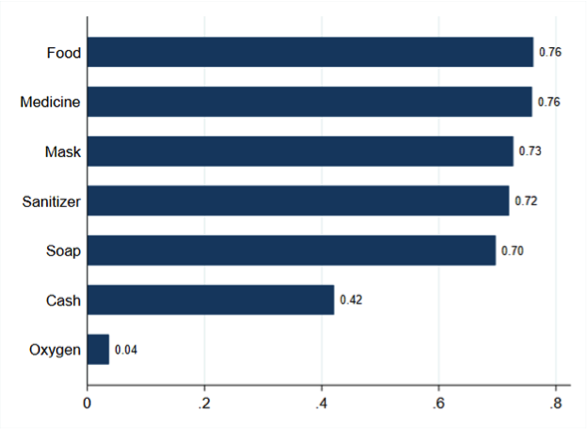
Types of assistance needed by the incidence of new cases of COVID-19 in August, 2020
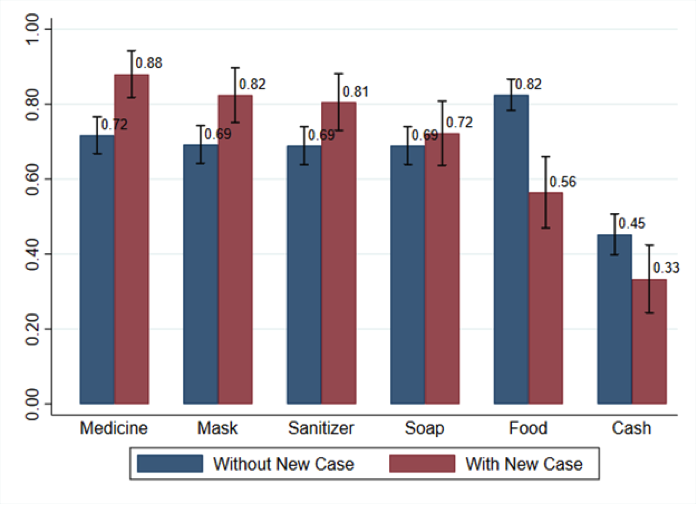
Notes: The difference for "Sanitizer" and "Cash" are statistically significant (p=0.012 and p=0.027, respectively).
Types of assistance needed in August 2020 by ethnicity.
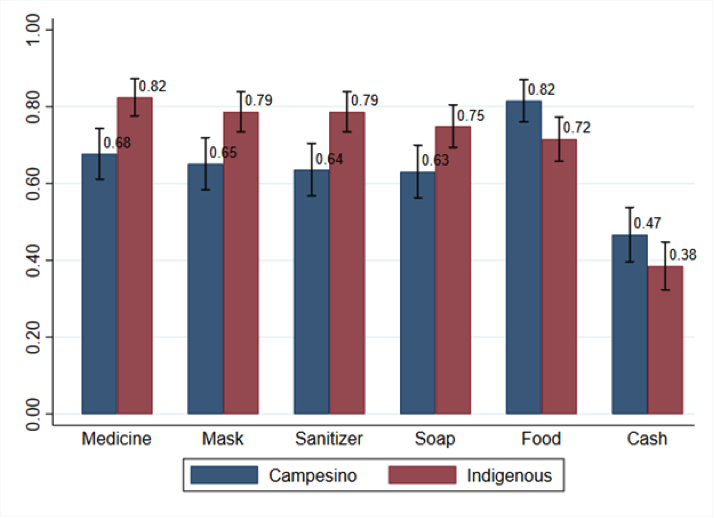
Notes: The difference for "Soap", "Food", and "Cash" ares statistically significant (p=0.012, p=0.014, and p=0.86, respectively).
Finding:
Rural communities received limited assistance: money helpful; food helpful too, especially because prices shot up for items typically bought in cities. Some communities reported that residents contracted COVID-19 in traveling to city to pick up their government COVID-19 subsidy; this may have led to mortality. Rural communities most need medical supplies (medicine, masks, sanitizer, soap) and food (especially among communities with new cases of COVID-19) and indigenous communities report greater need. Cash is relatively less needed.
Rural communities received limited assistance: money helpful; food helpful too, especially because prices shot up for items typically bought in cities. Some communities reported that residents contracted COVID-19 in traveling to city to pick up their government COVID-19 subsidy; this may have led to mortality. Rural communities most need medical supplies (medicine, masks, sanitizer, soap) and food (especially among communities with new cases of COVID-19) and indigenous communities report greater need. Cash is relatively less needed.
Major concerns among study communities in August, 2020
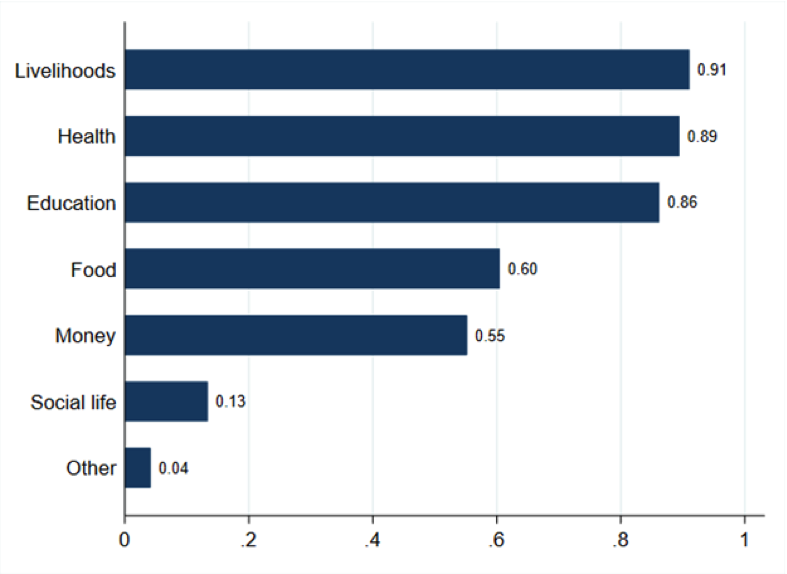
Expectations of future outbreak by the prevalence of COVID-19 in August, 2020
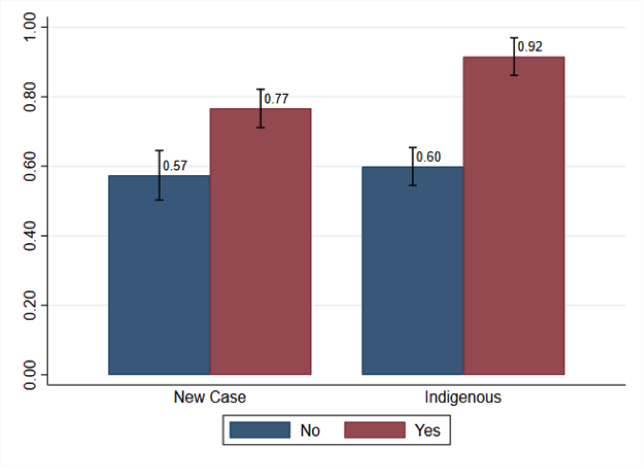
Notes: "Yes" refers to communities with new cases or indigenous communities. "No" refers to communities with no new case or campesino communities.
Finding:
Rural communities are concerned about livelihoods, health, and education. They are relatively less concerned about food and money. Whether they expect a next outbreak depends on the prevalence of new cases of COVID-19, especially among indigenous communities.
Rural communities are concerned about livelihoods, health, and education. They are relatively less concerned about food and money. Whether they expect a next outbreak depends on the prevalence of new cases of COVID-19, especially among indigenous communities.